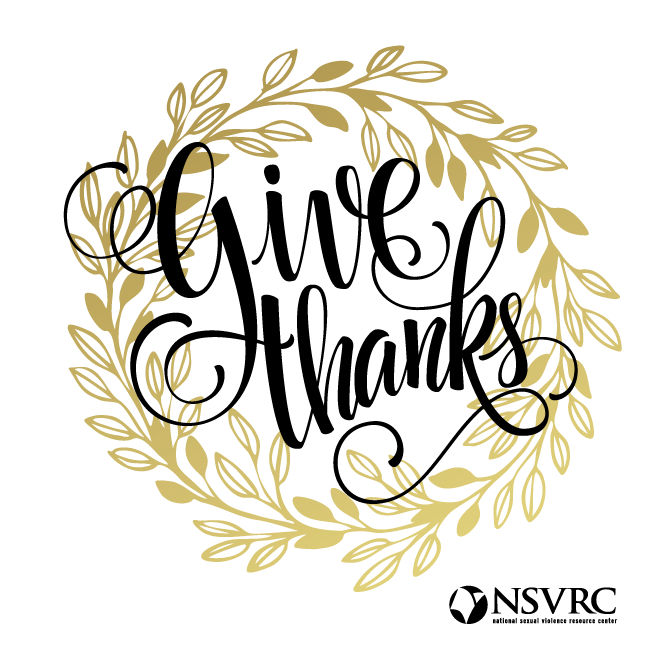
“We’re grateful to all who contributed to sexual assault prevention this year and everyone who continues to work tirelessly to achieve progress in the years to come.”
While there’s no question that we still face many challenges to fully preventing sexual assault – and this year was no exception – we’d like to take this holiday season to reflect on the significant signs of progress we saw in 2016. From Lady Gaga’s Oscars performance of “Til It Happens To You” and the Stanford sexual assault survivor’s viral statement to discussion of sexual assault in the presidential election, 2016 brought increased visibility to the issue. Heightened media attention and public outrage over high-profile cases such as those at college campuses like Baylor University, the criminal charges filed against Bill Cosby and from within institutions like hospitals and boarding schools illustrated the scope and impact of the problem and demonstrated how critical it is for individuals and communities to engage in response and prevention. As Thanksgiving nears, the National Sexual Violence Resource Center (NSVRC) would like to highlight five groups of people we’re thankful for this year:
1. Policymakers taking action
It has been a landmark year for policymakers taking notice of sexual assault. Vice President Biden appeared on Law & Order: SVU, spoke at numerous campuses during Sexual Assault Awareness Month and, along with President Obama, pledged to boycott campuses failing to take meaningful steps to address the issue. The non-partisan Survivors’ Bill of Rights, sponsored by Sen. Jeanne Shaheen (D-NH), was passed unanimously by Congress and signed by President Obama, setting a shining example of how the rights of sexual assault survivors should be prioritized in state and federal cases. States from Oregon to Georgia passed laws to mandate the testing of backlogged rape kits. Effective leadership and policies drive change, and we are grateful for the individuals, advocates and other groups who champion these steps.
2. Bystanders intervening
As individuals, we all have a role to play in creating safe environments. Bystanders are essential to both preventing and responding to sexual assault by identifying troubling behaviors and speaking up or changing the circumstances. We are thankful to individuals who modeled examples of the steps we all can take to create safe environments for others.
In some cases, bystanders like University of Florida football player Cristian Garcia stop a sexual assault before it even takes place. We’re grateful for bystander training initiatives such as Washington, D.C.’s Safe Bars program, which teaches bartenders to spot warning signs of a potential sexual assault and intervene to prevent it.
In other instances, bystanders are essential to securing justice for a victim. If not for the actions of Stanford graduate students Peter Jonsson and Carl Fredrik Arndt, who discovered Brock Turner and his victim and served as witnesses in the subsequent trial, the assault may have continued and Turner may not have been held accountable at all.
3. Members of the media amplifying survivors’ voices
Sexual violence – including rape, child sexual abuse and sexual harassment – is a complex topic, making informed and accurate reporting essential. We applaud the members of the media who helped the public better grasp the pervasiveness and seriousness of this issue by uncovering systemic problems and giving survivors a voice.
Ashleigh Banfield devoted half of her CNN show to reading the victim impact statement in the Brock Turner case, initially published on BuzzFeed. Platforms like Buzzfeed devoted ongoing coverage to the topic of campus sexual assault, helping students better understand their rights under Title IX, as well as the responsibility of their universities in supporting survivors and holding those who cause harm accountable. The Boston Globe’s Spotlight team — led by Jenn Abelson, Bella English, Jonathan Saltzman and Todd Wallack — continued its award-winning work, exposing decades of abuse and subsequent mishandling at private boarding schools in New England. Atlanta Journal-Constitution reporters Carrie Teegardin, Danny Robbins, Jeff Ernsthausen and Ariel Hart revealed disturbing instances of doctors sexually abusing patients. While the job of appropriately covering sexual violence can be difficult, these reporters took on the challenge to effectively increase public understanding.
4. Advocates supporting survivors
There’s no question that sexual violence burdens our society with major costs including chronic health issues, incarceration, lost productivity and other costs – but the good news is prevention is possible, and it’s happening. Individuals and advocacy groups across the country made meaningful progress in 2016.
For its 17th year, Peace Over Violence rallied Americans to wear jeans on Denim Day during Sexual Assault Awareness Month to demonstrate support for survivors and raise money to protect access to services and prevention materials. Amanda Nguyen, motivated by her own difficulty with the legal hurdles around rape kits, devoting countless hours to the passage of the Survivors’ Bill of Rights. Her organization, RISE, continues to advocate for policy change. And new voices joined the movement, with professional football player DeAndre Levy penning a column on educating young men about sexual assault and raising money for rape kit testing. NSVRC knows it will take even more individuals and organizations taking part in the sexual assault prevention movement to keep us on the path of change in the year ahead.
5. Survivors bravely sharing their stories
Kendra Heuer. Audrie Pott. Madi Barney. Delaney Robinson. Alec Fischer. Daisy Coleman. The Stanford victim.
The way communities often respond to victims can inflict shame, fear, humiliation and, ultimately, silence. Despite that, these and countless other survivors came forward this year to share their experiences, and the world listened. Chessy Prout made the brave decision to publicly reveal her identity on the Today Show in order to speak out about the traumatic crime committed against her by a fellow student at her private school. And Brenda Tracy, who was sexually assaulted by four college football players two decades ago, met with college athletes and coaches to discuss the role they have to play in prevention. While too many victims remain silenced – particularly men, people of color, people who identify as LGBTQ and older adults – we commend these survivors for their courage in sharing their stories to advance awareness and understanding and let other victims know they are not alone.
As Thanksgiving draws near, we’re grateful to all who contributed to sexual assault prevention this year and everyone who continues to work tirelessly to achieve progress in the years to come. This change is necessary now more than ever – but it doesn’t happen easily, and it’s not inevitable. Every one of us has a role to play and, together, we can end sexual violence once and for all.
